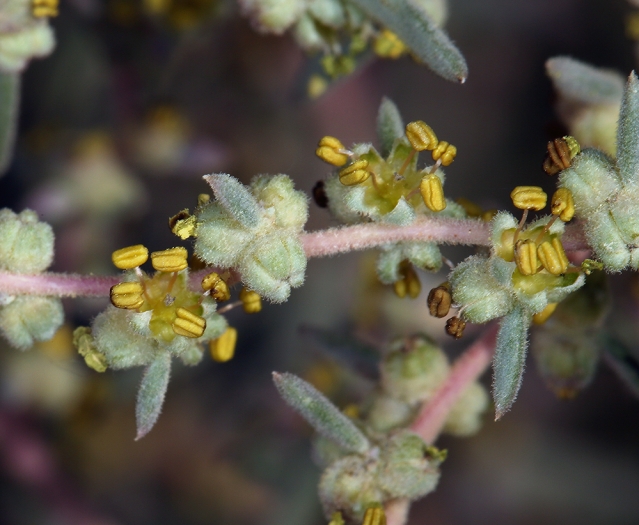Bush Seepweed
(Suaeda nigra)
Bush Seepweed (Suaeda nigra)
/
/

© Steve Matson
CC BY 4.0
Image By:
© Steve Matson
Recorded By:
Copyright:
CC BY 4.0
Copyright Notice:
Photo by: © Steve Matson | License Type: CC BY 4.0 | License URL: http://creativecommons.org/licenses/by/4.0/ | Uploader: matsonburger | Publisher: iNaturalist |

























Estimated Native Range
Summary
Suaeda nigra, commonly known as bush seepweed or Mojave sea-blite, is a perennial shrub in the amaranth family, native to saline and alkaline substrates in western North America, including desert flats, dry lakes, seeps, and estuaries. It is well-adapted to both inland and coastal saline habitats, often found in areas with high salt concentrations that would inhibit the growth of many other plants. Suaeda nigra typically reaches up to 5 feet in height and displays a range of colors from green to red or purple, depending on environmental conditions and the plant’s maturity. The succulent leaves are linear to lance-shaped, which helps the plant conserve water in its arid native habitat. Flowers are small, inconspicuous, and occur in clusters along the upper stems, usually blooming from late summer to fall.
Bush seepweed is valued for its ability to thrive in challenging saline environments and is often used for habitat restoration and erosion control in appropriate regions. Its tolerance for salt and drought makes it a low-maintenance option for xeriscaping and gardens that aim to conserve water. In cultivation, it requires full sun exposure and well-drained soils that mimic its natural saline conditions. While not commonly afflicted by diseases, it can suffer from root rot if overwatered or planted in poorly drained soils. It is not known to be invasive when grown outside its native range, but as with any plant, gardeners should consult local guidelines before introducing it to non-native areas.CC BY-SA 4.0
Bush seepweed is valued for its ability to thrive in challenging saline environments and is often used for habitat restoration and erosion control in appropriate regions. Its tolerance for salt and drought makes it a low-maintenance option for xeriscaping and gardens that aim to conserve water. In cultivation, it requires full sun exposure and well-drained soils that mimic its natural saline conditions. While not commonly afflicted by diseases, it can suffer from root rot if overwatered or planted in poorly drained soils. It is not known to be invasive when grown outside its native range, but as with any plant, gardeners should consult local guidelines before introducing it to non-native areas.CC BY-SA 4.0
Plant Description
- Plant Type: Shrub
- Height: 1-3 feet
- Width: 3-4 feet
- Growth Rate: Moderate
- Flower Color: Green
- Flowering Season: Summer
- Leaf Retention:
Growth Requirements
- Sun: Full Sun
- Water: Low
- Drainage: Medium
Common Uses
Erosion Control, Low Maintenance, Salt Tolerant
Natural Habitat
Saline and alkaline substrates in desert flats, dry lakes, seeps, estuaries, and other areas with high salt concentrations in western North America
Other Names
Common Names: Seablite, Mojave Sea-Blite, Seepweed, Moquin’s Sea-Blite, Torrey Seepweed, Black Seablight, Alkali Seepweed, Shrubby Seepweed
Scientific Names: , Suaeda nigra, Chenopodina linearis, Chenopodina moquinii, Chenopodium moquinii, Chenopodium nigrum, Dondia diffusa, Dondia intermedia, Dondia moquinii, Dondia multiflora
GBIF Accepted Name: